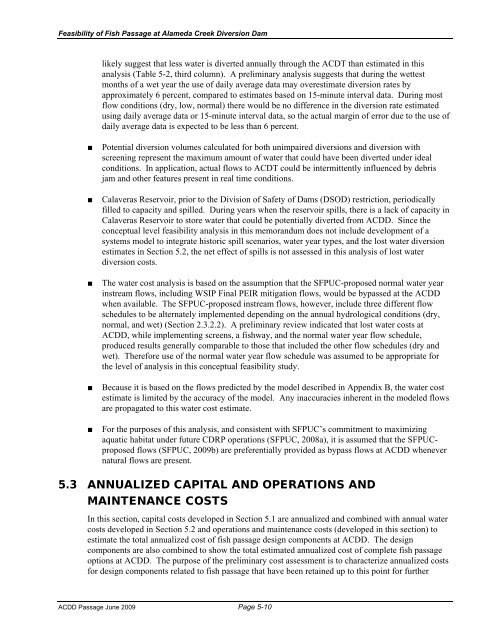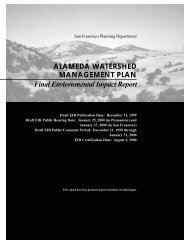Feasibility of Fish Passage at Alameda Creek Diversion Dam
Feasibility of Fish Passage at Alameda Creek Diversion Dam
Feasibility of Fish Passage at Alameda Creek Diversion Dam
You also want an ePaper? Increase the reach of your titles
YUMPU automatically turns print PDFs into web optimized ePapers that Google loves.
<strong>Feasibility</strong> <strong>of</strong> <strong>Fish</strong> <strong>Passage</strong> <strong>at</strong> <strong>Alameda</strong> <strong>Creek</strong> <strong>Diversion</strong> <strong>Dam</strong>likely suggest th<strong>at</strong> less w<strong>at</strong>er is diverted annually through the ACDT than estim<strong>at</strong>ed in thisanalysis (Table 5-2, third column). A preliminary analysis suggests th<strong>at</strong> during the wettestmonths <strong>of</strong> a wet year the use <strong>of</strong> daily average d<strong>at</strong>a may overestim<strong>at</strong>e diversion r<strong>at</strong>es byapproxim<strong>at</strong>ely 6 percent, compared to estim<strong>at</strong>es based on 15-minute interval d<strong>at</strong>a. During mostflow conditions (dry, low, normal) there would be no difference in the diversion r<strong>at</strong>e estim<strong>at</strong>edusing daily average d<strong>at</strong>a or 15-minute interval d<strong>at</strong>a, so the actual margin <strong>of</strong> error due to the use <strong>of</strong>daily average d<strong>at</strong>a is expected to be less than 6 percent.■■■■■Potential diversion volumes calcul<strong>at</strong>ed for both unimpaired diversions and diversion withscreening represent the maximum amount <strong>of</strong> w<strong>at</strong>er th<strong>at</strong> could have been diverted under idealconditions. In applic<strong>at</strong>ion, actual flows to ACDT could be intermittently influenced by debrisjam and other fe<strong>at</strong>ures present in real time conditions.Calaveras Reservoir, prior to the Division <strong>of</strong> Safety <strong>of</strong> <strong>Dam</strong>s (DSOD) restriction, periodicallyfilled to capacity and spilled. During years when the reservoir spills, there is a lack <strong>of</strong> capacity inCalaveras Reservoir to store w<strong>at</strong>er th<strong>at</strong> could be potentially diverted from ACDD. Since theconceptual level feasibility analysis in this memorandum does not include development <strong>of</strong> asystems model to integr<strong>at</strong>e historic spill scenarios, w<strong>at</strong>er year types, and the lost w<strong>at</strong>er diversionestim<strong>at</strong>es in Section 5.2, the net effect <strong>of</strong> spills is not assessed in this analysis <strong>of</strong> lost w<strong>at</strong>erdiversion costs.The w<strong>at</strong>er cost analysis is based on the assumption th<strong>at</strong> the SFPUC-proposed normal w<strong>at</strong>er yearinstream flows, including WSIP Final PEIR mitig<strong>at</strong>ion flows, would be bypassed <strong>at</strong> the ACDDwhen available. The SFPUC-proposed instream flows, however, include three different flowschedules to be altern<strong>at</strong>ely implemented depending on the annual hydrological conditions (dry,normal, and wet) (Section 2.3.2.2). A preliminary review indic<strong>at</strong>ed th<strong>at</strong> lost w<strong>at</strong>er costs <strong>at</strong>ACDD, while implementing screens, a fishway, and the normal w<strong>at</strong>er year flow schedule,produced results generally comparable to those th<strong>at</strong> included the other flow schedules (dry andwet). Therefore use <strong>of</strong> the normal w<strong>at</strong>er year flow schedule was assumed to be appropri<strong>at</strong>e forthe level <strong>of</strong> analysis in this conceptual feasibility study.Because it is based on the flows predicted by the model described in Appendix B, the w<strong>at</strong>er costestim<strong>at</strong>e is limited by the accuracy <strong>of</strong> the model. Any inaccuracies inherent in the modeled flowsare propag<strong>at</strong>ed to this w<strong>at</strong>er cost estim<strong>at</strong>e.For the purposes <strong>of</strong> this analysis, and consistent with SFPUC’s commitment to maximizingaqu<strong>at</strong>ic habit<strong>at</strong> under future CDRP oper<strong>at</strong>ions (SFPUC, 2008a), it is assumed th<strong>at</strong> the SFPUCproposedflows (SFPUC, 2009b) are preferentially provided as bypass flows <strong>at</strong> ACDD whenevern<strong>at</strong>ural flows are present.5.3 ANNUALIZED CAPITAL AND OPERATIONS ANDMAINTENANCE COSTSIn this section, capital costs developed in Section 5.1 are annualized and combined with annual w<strong>at</strong>ercosts developed in Section 5.2 and oper<strong>at</strong>ions and maintenance costs (developed in this section) toestim<strong>at</strong>e the total annualized cost <strong>of</strong> fish passage design components <strong>at</strong> ACDD. The designcomponents are also combined to show the total estim<strong>at</strong>ed annualized cost <strong>of</strong> complete fish passageoptions <strong>at</strong> ACDD. The purpose <strong>of</strong> the preliminary cost assessment is to characterize annualized costsfor design components rel<strong>at</strong>ed to fish passage th<strong>at</strong> have been retained up to this point for furtherACDD <strong>Passage</strong> June 2009 Page 5-10








